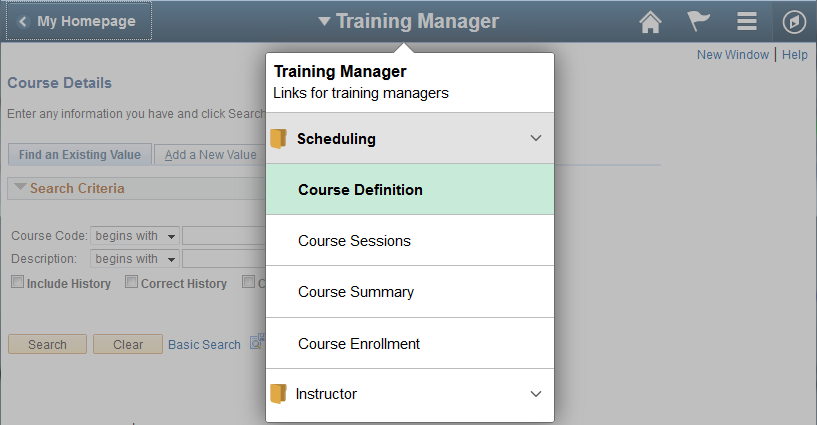Using Activity Guides
Activity guides are a PeopleTools feature that allow you to define guided procedures for a user or group of users to complete. An activity guide divides related action items into a series of tasks or steps. It enables users to see exactly where they are in a process as they progress towards completion. Activity guides track the status of your tasks or steps. Activity guides can be useful in a number of procedural scenarios. For example:
The on-boarding of a new employee.
Benefits enrollment.
A life change event, such as a marriage or the birth of a child.
Period end closing.
System or feature configuration.
There are several mechanisms for users to access and display an activity guide:
Classic activity guides require an activity guide pagelet, which is the interface that presents the activity guide and its action items to a user. The pagelet lists tasks in order and can optionally include a status bar indicating completion progress. Activity guide pagelets must be accessed through a classic WorkCenter.
Fluid activity guides can be accessed in a number of ways including:
Through a tile that opens the specified activity guide instance.
Through a related action link.
Through a tile that opens the My Activity Guide Instances page listing all activity guide instances for that template that the user is contributor to.
Through a menu item.
Through a button or link that programmatically generates the URL for the activity guide.
Activity Guide Process Types
There are seven activity process types. Depending on the process type used by the developer to create the activity guide, the display and use of the activity guide will differ.
|
Activity Guide Template Type |
Description |
|---|---|
|
Horizontal optimized guided sequential |
|
|
Vertical optimized guided sequential |
|
|
Vertical optimized guided non-sequential |
|
|
Vertical optimized non-guided non-sequential |
|
|
Vertical non-optimized guided sequential |
|
|
Vertical non-optimized guided non-sequential |
|
|
Vertical non-optimized non-guided non-sequential |
|
Activity guides provide a hierarchical organization of dependent and sequential tasks. An activity guide lists the tasks, also referred to as action items, that you need to complete. Each action item is linked to a specific local or remote transaction or external URL. Some activity guides may include a questionnaire that includes questions used to determine which steps or tasks will be included in the action items.
How the lists and navigations is presented on the page depends on whether you are accessing a classic activity guide or a Fluid activity guide.
Classic – As you use an activity guide, you see the lists of action items that you need to complete in the pagelet area. When you click an action item, the associated page appears in the target content area of the WorkCenter. To complete an action item, complete the associated page, and save your work; the status of the action item will update to complete. The activity guide pagelet remains visible as you move from step to step, with the current action item highlighted, and you can see your progress by viewing the Task Progress bar, if included, that is located at the top of the activity guide pagelet. An icon appears next to each activity item to indicate its status.
A navigation frame appears above the target content area, which includes buttons that enable you to navigate through each action item. Next and Previous buttons are provided; additional buttons and controls may also appear, if defined by the Activity Guide developer, such as the Mark as Complete button that you see in some of the examples we provide below. Typically, these additional buttons enable you to mark an action item as complete or cancel your actions.
Fluid — Action items may be displayed either vertically or horizontally on the page depending on the activity guide template used by the developer to create the page.
Guided activity guides include Next and Previous buttons for navigation in the activity guide subbanner. Non-guided activity guides do not include any default navigation buttons. Both types can include custom buttons in the activity guide subbanner.
Action items can include the following characteristics:
Action items can be required or optional.
An asterisk designates a required action item. For an activity guide status to be designated as complete, all required action items must have a complete status.
Action items can be organized hierarchically with a parent (summary) action item composed of child (detail) action items.
All required child action items must be complete before the parent item is considered complete.
Note: Parent action items are collapsible/expandable headings which groups related tasks; they do not load content in the target area when clicked.
Action items can be date-dependent and include required start or completion dates.
Action items can include dependencies; for example, one action item can be set to be dependent on the status of another action item.
Action item access can be controlled by role. If you do not have permission to access an action item, it will be disabled and you will not be able to access it.
Classic activity guides require an activity guide pagelet, which is the interface that presents the activity guide and its action items to a user. The pagelet lists tasks in order and can optionally include a status bar indicating completion progress. Classic activity guides and pagelets must be accessed through a classic WorkCenter.
Activity Guide Icons and Controls
This table describes the icons and controls for a classic activity guide:
|
Field or Control |
Definition |
|---|---|
 Task is not started Task is not started |
Indicates the task has not been started. |
 Task is visited Task is visited |
Indicates you have visited the task and it is in progress, but it is not complete yet. |
 Required Required |
A red asterisk displays to the left of each required task. If a step is not required, the status can be changed from Not Started to Visited. |
 Task is completed Task is completed |
Indicates you have completed the task. |
 Task is in progress Task is in progress |
Indicates that a required task is not yet complete. In addition, it designates a summary task that has required detail tasks that are not yet complete. |
 Task is overdue Task is overdue |
Indicates a task that is past its due date. |
 Task is dependent Task is dependent |
Indicates that the task is dependent on the completion of one or more tasks or steps and cannot be started yet. Click the task to view the dependencies. |
 Expand Expand |
Click to expand a summary (parent) action item, and view its subordinate tasks. |
 Collapse Collapse |
Click to collapse a summary (parent) action item, and hide its subordinate tasks. |
 |
Click this button to navigate to the next step. |
 |
Click this button to navigate to the previous step. |
Classic Activity Guide Examples
This section shows several examples of classic activity guides.
Image: IB Configure Network activity guide with completed tasks
This activity guide contains tasks to configure Integration Broker (IB). In this example, the IB Configure Network Activity Guide pagelet appears in the pagelet area of the Integration Network WorkCenter page, with the Gateways page in the target content area.
In this example, the first task has been completed, but none of the other tasks has been visited.
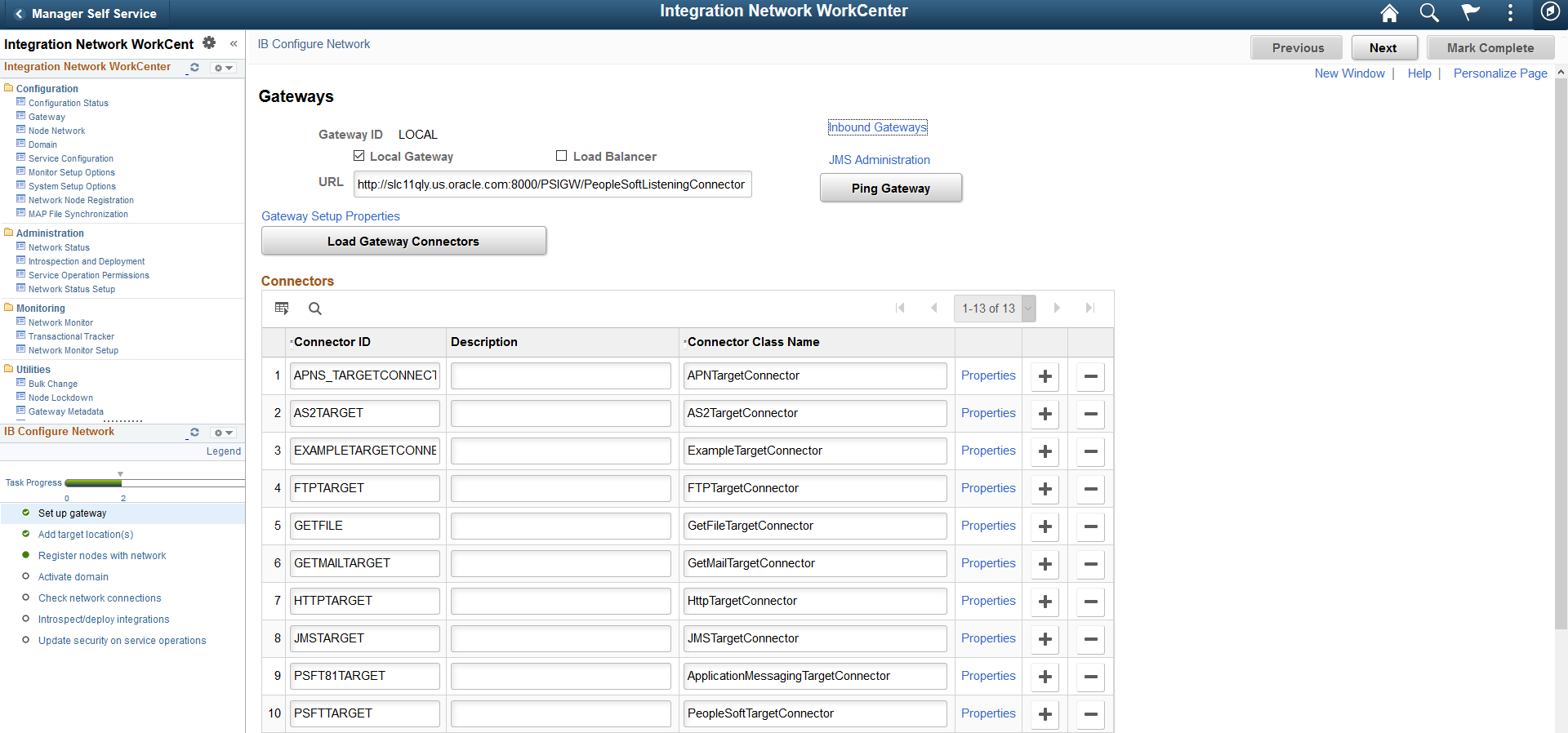
Image: Life Events classic activity guide
This example shows a Life Events activity guide. This activity guide includes required tasks, which are indicated by an asterisk, as well as the summary task Pay and Compensation (expanded) and a dependent task, Benefit Enrollment. The Benefit Enrollment task is dependent on the completion of Birth Date task, which is currently in progress.

For guided processes, the activity guide subbanner displays the standard Next and Previous navigation buttons. Custom navigation buttons are displayed in the activity guide subbanner for all activity guide types.
Fluid Activity Guide Icons and Controls
This table describes the icons and controls for fluid activity guides:
|
Field or Control |
Definition |
|---|---|
 or or  Next Next |
Click this button to navigate to the next step. |
 or or  Previous Previous |
Click this button to navigate to the previous step. |
 Activity Guide
Navigation Area Activity Guide
Navigation Area |
When viewing on small form factor device, the action item list will be hidden. Click the left panel tab button to display the tasks or steps in the activity guide. |
Examples of Horizontal Guided Sequential Activity Guides
In a horizontal sequential guided activity guide, the steps are presented across the top of the page, with the current step shaded in green. When the activity guide is displayed on a phone or tablet, the task progress bar will show the current progress and the step number.
Image: Payment Request activity guide
The Payment Request activity guide is an example of a horizontal guided sequential activity guide. Each task must be completed in order. The current step or task number is shaded green. Click the Next button to move to the next task.
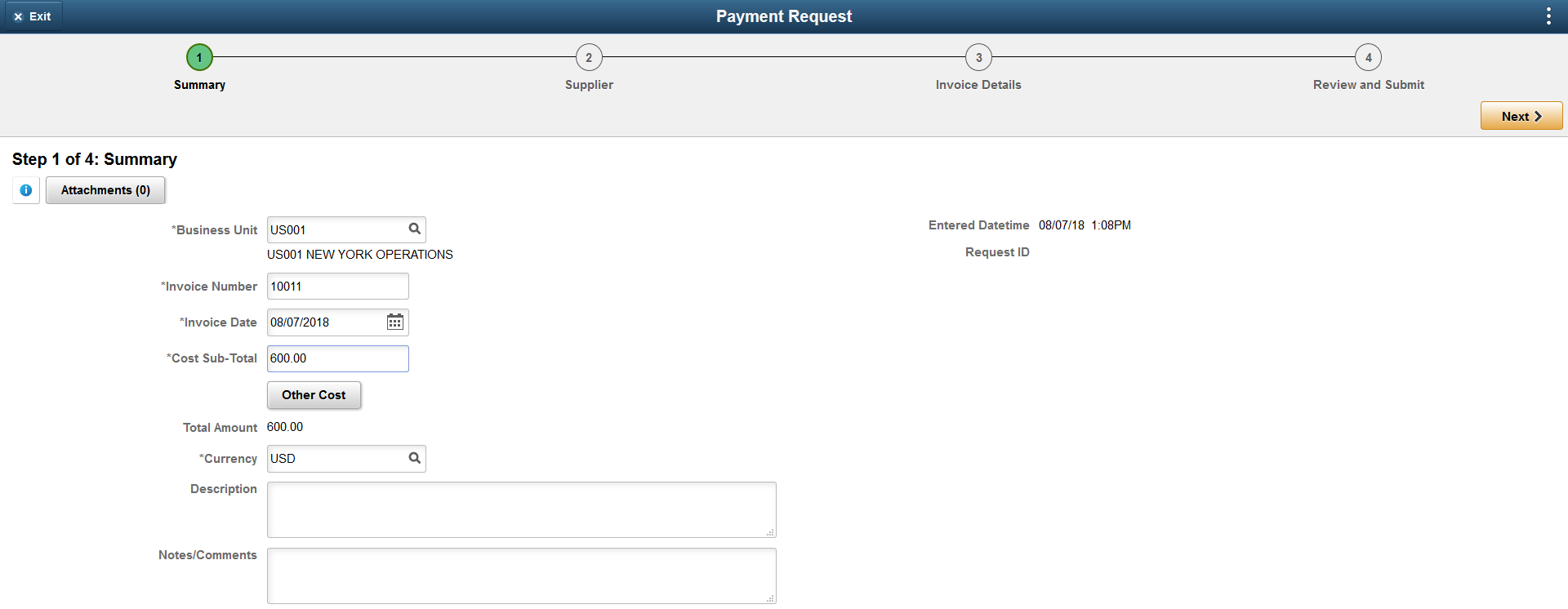
The final step or task in a horizontal guided sequential activity guide will include a Submit button.
Image: Payment Request step 4
This example shows the last task for a Payment Request, when all of required information has been entered, the navigation bar will contain a Submit button.
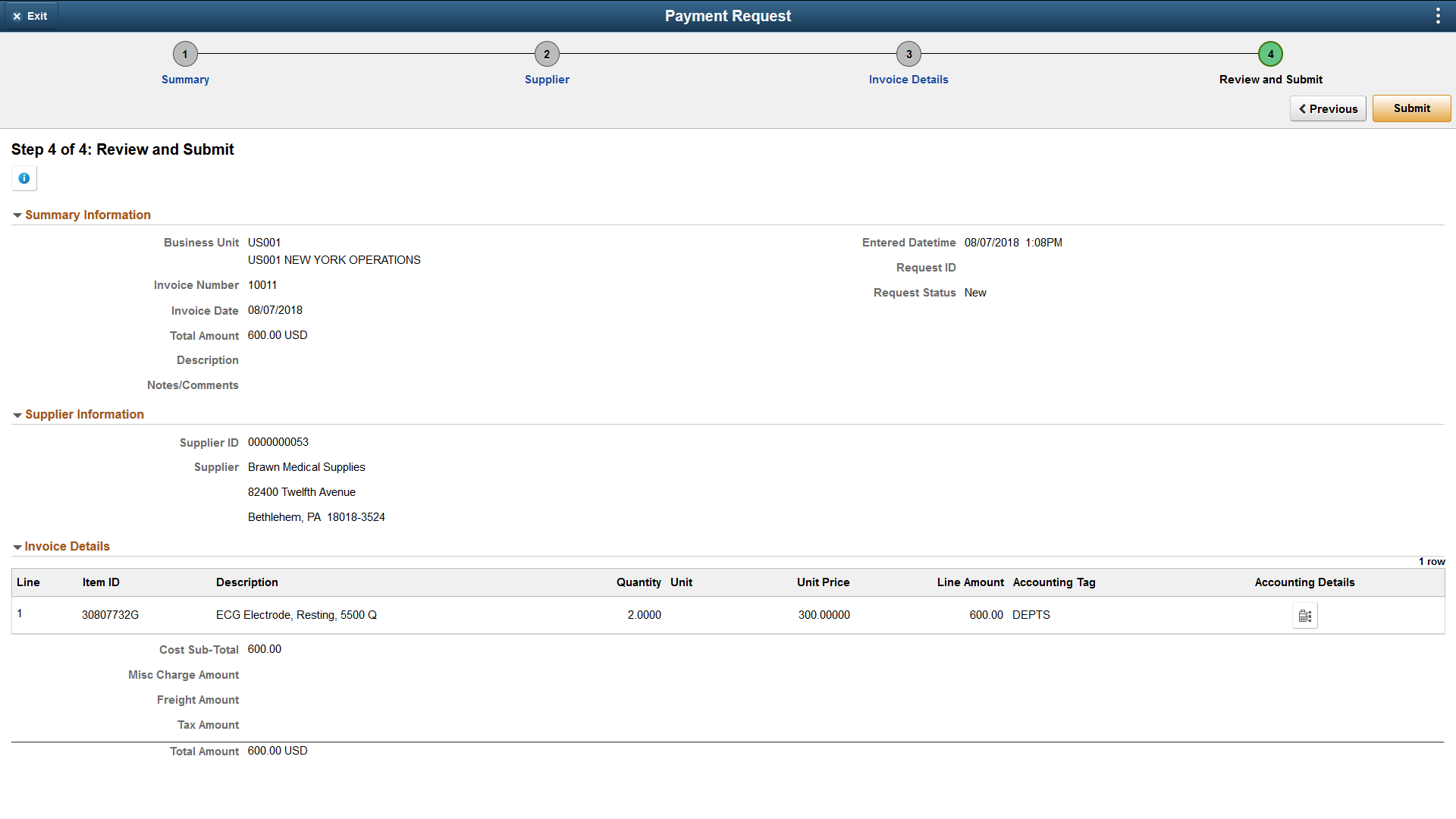
Image: Promote Employee activity guide with related information
This example illustrates a horizontal guided sequential activity guide that contains a supplementary decision support information displayed in the Related Information panel.
Note: If the activity guide has related content, use the Supplementary Panel button to expand the right panel when the activity guide is displayed on a phone.

Examples of Vertical Guided Sequential Activity Guides
In a vertical guided sequential activity guide the numbered steps are presented vertically in the left panel. The current step is shaded in green and the step status is displayed for each step. When the page is displayed on a phone or tablet, the left panel is collapsed and the progress bar is displayed at the top of the page along with the step number.
Image: Expenses Hotel Wizard with some tasks complete
This example illustrates a vertical guided sequential activity guide. In this example, the tasks are displayed vertically on the left-hand side of the page. When you complete the task and click Next, the next task will be displayed.

Image: Expenses Hotel Wizard on a smart phone
This example illustrates a vertical guided sequential activity guide as it is displayed on a smart phone. On the left, the left panel is collapsed and the action item list is not visible. On the right, the left panel is expanded, and the action items are visible. The progress bar visually indicates completion progress along with the step number.
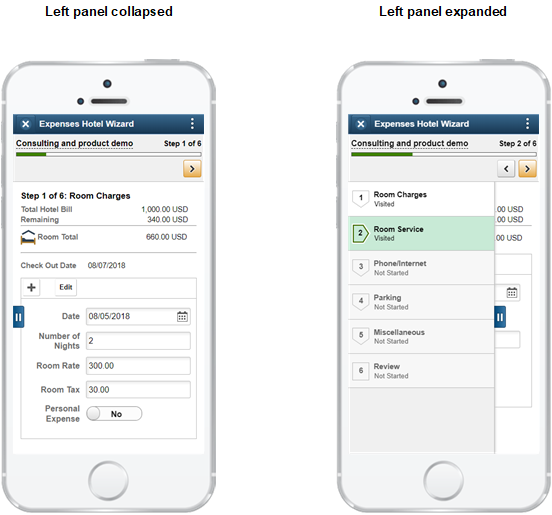
Example of a Vertical Guided Non-Sequential Activity Guide
In a vertical guided non-sequential activity guide the numbered steps are presented vertically in the left panel. The current step is shaded in green and the step status is displayed for each step. When the page is displayed on a phone or tablet, the left panel is collapsed.
The following icons and controls are used with the vertical guided non sequential activity guides:
|
Field or Control |
Definition |
|---|---|
 Not Started Not Started |
Indicates the task has not been started. |
 Visited Visited |
Indicates you have visited the task, but not completed it. |
 In Progress In Progress |
Indicates that a required task is not yet complete. In addition, it designates a summary task that has required detail tasks that are not yet complete. |
 Complete Complete |
Indicates you have completed the task. |
 Required Required |
A red asterisk displays to the left of each required step. If a step is not required, the status can be changed from Not Started to Visited. |
 Expand Expand |
Click to expand a summary (parent) action item, and view its substeps. |
 Collapse Collapse |
Click to collapse a summary (parent) action item, and hide its substeps. |
| Locked |
Steps that have a dependency will be grayed out and the status will indicate Locked (View Dependency). Click or tap on the step and a modal will open to show the dependencies. |
| Pending Approval |
Indicates the task or step is waiting for approval through the approval framework. |
Image: Birth Event fluid activity guide
This example illustrates a vertical guided non-sequential activity guide. Required tasks, such as Birth Date, are indicated by an asterisk. Dependent tasks, such as Benefit Summary, are grayed indicating that they cannot be started until one or more tasks have been completed; click the task to view the dependencies..
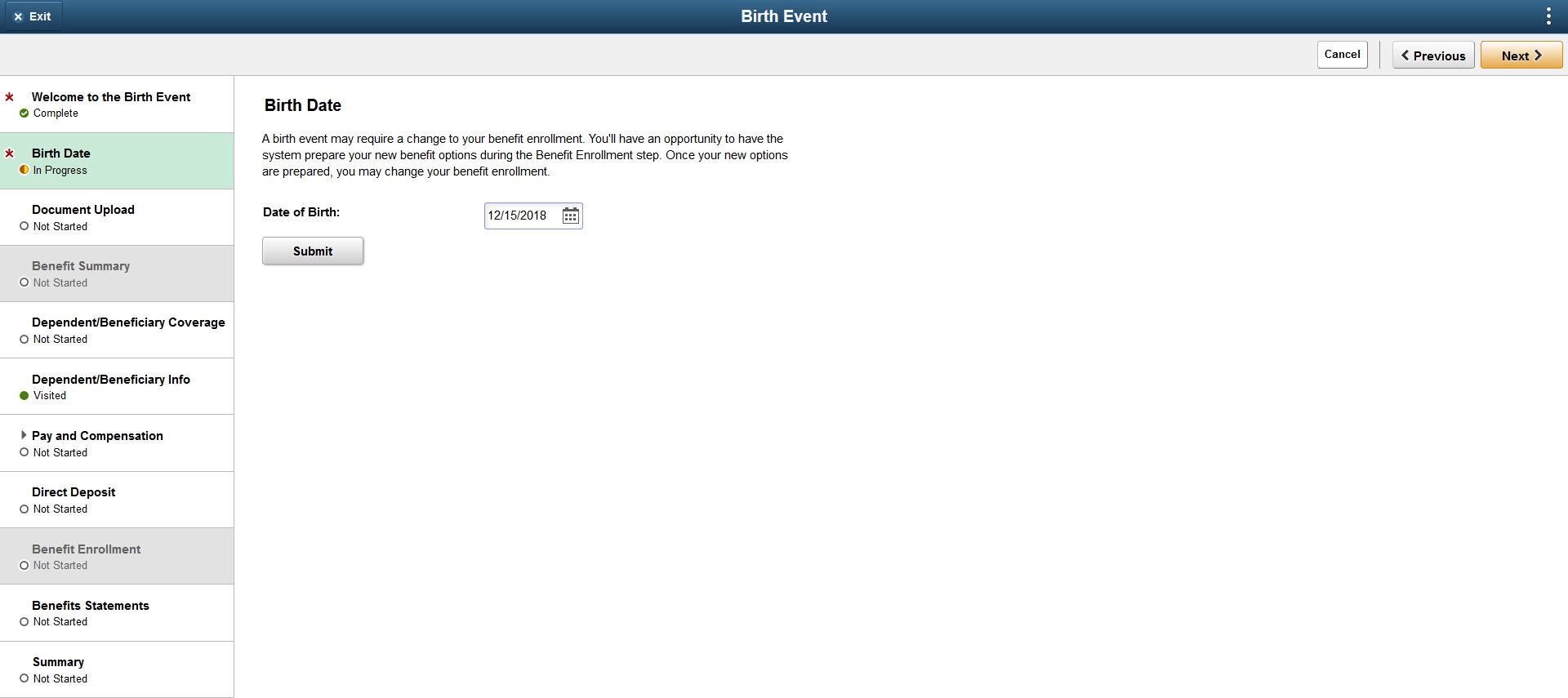
Example of a Non-Optimized Activity Guide
Non-optimized activity guides list the steps or tasks in a drop-down selector from the middle of the banner versus in the left panel.
Image: Example of a non-optimized activity guide
This example illustrates how a non-optimized activity guide is displayed. This example uses a navigation collection instead of an actual activity guide.
